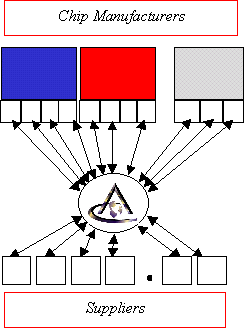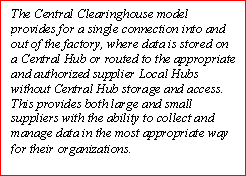The Central Clearinghouse model
The Central Celaringhouse strategy eliminates many of the inefficiencies in semiconductor manufacturing by facilitating real-time information exchange between device manufacturers and their equipment and materials suppliers through the use of Internet technology. This model provides many benefits over the point-to-point model, such as: single point of entry/exit to the manufacturing facility, simplified management of network for both security and user management, easier and faster implementation, consistent interface of hardware and software and substantially lower cost than multiple point-to-point connections. The central clearinghouse model also provides for the ability to store data on a secure central hub for access by authorized parties or it provides for the routing of data to the authorized parties without central storage and access. The following diagram illustrates this point:

Figure 3: The Central Clearinghouse model brings order out of chaos by mediating the flow of e-diagnostic information between tool suppliers and semiconductor manufacturers.
Figure 3 details the Central Clearinghouse system. The system manages routing of messages sent from the fab to the appropriate vendor destination. This ensures that data meant for supplier #1 only goes to supplier #1 and not to supplier #2.

These messages all travel over the Internet through a Virtual Private Network (VPN) ensuring secure connections and data transmission. The equipment vendor similarly has just one link to maintain.
Authorized Queries mean fab data is protected
The vendor's diagnostic expert has the ability to send authorized queries remotely through the network to get more information from the tool that's in trouble. Those queries have been pre-authorized by the factory, so the vendor's diagnostic experts can ask for only information that the fab's management has previously determined that they are willing to share with them. So, a diagnostician at the supplier can say: "Our tool is down and I need information. Let's run query #27." In this way, the diagnostician can get data from the tool, but the factory also has control over what data they are sending.
Semiconductor fabs using the network maintain physical control over their intellectual property because process information resides on a server at their location. Information needed by the diagnostician is sent, in response to a query, over the secure link to the supplier.
Getting Help Fast
To improve tool utilization, the first order of business is to attack the mean time to respond and mean time to repair a problem. The best way to do that is to notify someone quickly.
The following table details a typical scenario:
| Manual Reporting | Hours | Cost | Automatic Reporting - Tool Driven | Hours | Cost | ||
|
|
Equipment alarm occurs; critical unit of process equipment goes down | Equipment alarm occurs; critical unit of process equipment goes down | |||||
|
|
Operator notices alarm and reports it to "equipment manager." |
|
|
||||
|
|
Equipment manager performs triage to determine if this is a critical failure and contacts on-site, supplier field service technician. |
|
|
Equipment supplier's expert 24x7x365 global triage center calls "equipment manager", notifies them of the alarm condition, and begins to diagnose the problem. |
|
|
|
|
|
Technician gowns up and enters cleanroom. |
|
|
If the equipment does not provide enough remote diagnostic capability the technician may still need to enter the cleanroom and begin diagnosing the problem. |
|
$100,000 |
|
|
|
Technician diagnoses problem. May need to contact headquarters for help. |
|
|
Equipment supplier's 24x7x365 global triage center works with technician to propose a solution based on tool data and comparative analysis with tools in other factories. |
|
|
|
|
|
Technician locates parts in stock. |
|
|
Technician locates parts in stock. |
|
|
|
|
|
Technician re-enters cleanroom and fixes equipment. |
|
|
Technician enters cleanroom with correct parts, latest schematics and solution in hand, and fixes equipment. |
|
|
|
|
|
Technician requalifies tool. |
|
|
Technician requalifies tool. |
|
|
|
|
|
Equipment back online. | Equipment back online. | |||||
|
Hours |
Million |
Hours |
|
The bottom line: Automatic reporting and 24x7x365 triage centers could save up to $300,000 per critical tool failure!
- Alert notification and escalation:
Field rep is automatically paged, emailed or phoned by the network due to tool down situation. Escalations occur if down time continues past pre-specified length.
- Remote e-diagnostics:
Field rep and support staff at supplier location can analyze problem via the network to determine probable cause prior to dispatching correct staff with correct parts to customer site. This can eliminate need to "gown-up" and enter fab to diagnose problem, saving at least 1 to 1.5 hours ($100K-$150K).
- Reference knowledge base and best practices:
Service staff will access knowledge base and best practices databases to determine corrective action. Due to central location, if this problem has happened at any location in the field, service staff will be informed!
- Field service rep. works on tool:
Correct parts and manuals are made available to get the tool back up quickly.
- Billing and spare parts inventory control:
Access to service contract and BOM information via the network can be utilized for correct billing and spare parts management. Time and materials information can be fed directly to supplier's billing system.
- Operator training:
The network will identify which operator was on shift at the time of the failure. This may lead to actions such as learning the tool state prior to failure and assigning the operator additional training.
- Information feedback:
Data can be fed back from the network to service support staff at the supplier location(s) to populate the knowledge base and best practices databases.
- Results:
Mean Time To Respond and Mean Time To Repair are reduced.
The Benefits of Diagnostic Data
When new fab construction costs $1B to $2B, semiconductor manufacturers have to get a very rapid return on investment. Downtime rapidly becomes very expensive.
In addition to the 15% taken up by unscheduled downtime and scheduled maintenance, the typical tool spends 27% of its time on set up and running test wafers, and 14% of its time just sitting around doing nothing. About half of a tool's life is spent doing something productive!
With semiconductor equipment productivity at around 50%, there is a big opportunity to increase it by applying proactive asset management. This means building more intelligent process tools and optimizing their performance. The Internet and secure networks will help make this goal a reality through the exchange of information between the fabs and their tool suppliers.
Through the secure network, tool vendors can gather and analyze real-time status and parametric data from equipment operating in the field. This data can give them better information about how their products perform. With better knowledge, they can develop optimization guidelines and predictive maintenance practices to keep the tools up and running at peak utilization.
Today, most device manufacturers do not share production data with their suppliers. They receive reactive support from suppliers' field service organizations. They don't get the kind of proactive support that could help them increase tool utilization and avoid problems.
Tomorrow's suppliers will need to be kept in-the-loop in real-time in order to ensure peak efficiency for their tools.
Data Security
A worldwide network supporting the far-flung operations of chip companies and their tools suppliers must, of course, be very secure and auditable. A secure, neutral information clearinghouse is essential to the industry. The security model should provide firewall-to-firewall authenticated and encrypted data streams, proof positive identification of both sender and receiver, prevention of data tampering or modification, and blocking of any fraudulent data. Additionally, any system like this should be audited not only by the constituents but by one of the big five accounting firms.
Conclusions
The IC manufacturer has complete control over what data can be collected within the fab and what can pass through the firewall from the hub to the network. A contractual agreement between the tool supplier and the IC manufacturer will define all intellectual property issues, such as what data can be published by a tool or sent to the hub and beyond.
The time is now to connect semiconductor manufacturer tools to their suppliers in order to improve tool productivity and significantly enhance the relationship between tool vendors and semiconductor manufacturers, by fostering communication and collaboration. The network will enable tool vendors to capture and analyze in-depth both tool status and performance information, helping reduce downtime, improve throughput, and respond more quickly when problems occur.
Biography
Chris Saso
AvantCom
Tel: 510-403-2106
E-mail: Saso, Chris [email protected]
Chris Saso has worked in the semiconductor industry since 1991. He has extensive background in semiconductor manufacturing factory automation, applying equipment control technologies and SECS/GEM communications standards to three product lines during his work at Watkins-Johnson. Prior to joining AvantCom Network Saso spent over four years at GW Associates, Inc. the leading provider of SECS/GEM software solutions. Saso provided technical sales and marketing expertise as well training and product requirements generation in his job as Technical Sales Manager. At AvantCom Network Saso is facilitating the paradigm shift that is taking place in the industry about how semiconductor manufacturing will be reshaped through the use of e-diagnostics and information exchanges between equipment suppliers and their customers.
